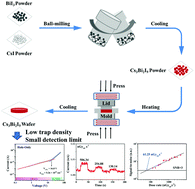Inch-size Cs3Bi2I9 polycrystalline wafers with near-intrinsic properties for ultralow-detection-limit X-ray detection†
Abstract
Lead-free perovskites are promising for next-generation bio-friendly X-ray detector materials, while it remains a challenge to fabricate high-quality wafers at a macroscopic scale using a readily scalable method. Herein, a solvent-free mechanochemical fabrication method is developed to produce inch-size lead-free perovskite Cs3Bi2I9 crystalline-wafers. It is surprising to see that these polycrystalline wafers exhibit near-intrinsic properties, and more specifically, the apparent trap density is measured to be as low as 5.26 × 10−10 cm−3, essentially the same as that of their single-crystal counterparts. Therefore, the X-ray detector fabricated on the Cs3Bi2I9 wafer delivers high sensitivity up to 230.46 ± 19.86 μC Gyair−1 cm−2 and a detection limit as low as 61.25 nGyair s−1 under a 40 kV X-ray source and 40 V mm−1 electric field. This research provides a readily scalable method for fabricating large perovskite wafers with near-intrinsic properties for general commercial applications.

- This article is part of the themed collection: Editor’s choice collection: luminescent metal halides


 Please wait while we load your content...
Please wait while we load your content...